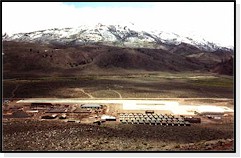|
|
About AM-2 Matting
Expeditionary Airfields (EAFs) are mobile systems that enable
the United States military to project airpowers worldwide. EAFs
offer more flexibility in staging grounds, operations bases and
campaign strategy. EAFs are composed of three integral systems -
AM-2 Aluminum Matting, Portable Aircraft Arresting Gear and
Marking (lighting) Systems. AM-2 matting is the base upon which
the entire EAF system rests.
AM-2 matting consists of 1 1/2" x 2' steel rectangles coated
with a epoxy nonskid material, available in both 6 and 12 foot
lengths, and are assembled in a brickwork pattern to form
runways, taxiways, parking and other areas required for aircraft
operations and maintenance. Thirty ISO containers can be
constructed to form a 1,500 square foot vertical, short landing
and take off airfield and can accommodate up to a total of
eleven CH53, UH1, AH1 and AV8B aircraft. AM-2 matting forms the
foundation that allows military commanders to configure an
airfield to ever-changing front line conditions.
CASS Services currently has contracts with the Naval Air
Warfare Center to re-manufacture AM-2 Matting and manufacture
accessory items for EAF activities. Under this re-manufacture
contract, CASS cleans, repairs and re-coats the AM-2 matting
with an epoxy, nonskid coating. The epoxy, nonskid coating is
specifically formulated to withstand the rigors imposed on EAFs
by today's high power jets, heavy transport aircraft and
arresting hook impact.
Expeditionary AirfieldsExpeditionary Airfields (EAFs) are
portable airfields that can be constructed, used, broken down after the
completion of a mission and moved to another site for re-use. The
development of EAF technologies and the storage of these assets on MPF
ships has reduced the US deployment time to any theatre of operations in
the world from 9-10 weeks to 2-3 weeks and allows for changing front
line conditions.
Originally made of pierced steel planks (PSP), portable runways were
first used during the critical campaigns toward the end of WWII.
Portable runways made possible the United States strategy of island
hopping during these campaigns. Although PSP worked well with the
aircraft of the WWII era, PSP could not endure the rigors placed on it
by the post WWII generation of jet aircraft. PSP simply could not
withstand the heavier wheel loads and impact of this new class of
aircraft. AM-2 Matting was developed to meet this need.
By the time of the Vietnam War, AM-2 Matting and EAFs were in full
service to both the Airforce and Marine Corps with over 10 million
square feet of matting in use. It was during this time that the use of
AM-2 Matting was expanded from its traditional use in SATS (Short
Airfield for Tactical Support) to include small helicopter pads (72 feet
square) which could be constructed in otherwise unprepared areas. These
small helicopter pads later evolved into landing pads for vertical
take-off and landing (VTOL) sites for non-helo aircraft with vertical
flight capabilities.
EAFs are constructed on-site by the Marine's Wing Support Squadron
and Navy Mobile Construction Battalions. Edge clamps, cruciform stakes
and earth anchors are used to secure the AM-2 Matting to the ground once
it has been properly laid out. Once the AM-2 Matting is securely
installed, the portable aircraft arresting gear and marking systems are
installed to form a complete airfield that enables air activity at
night, in inclement weather conditions, and otherwise unprepared
environments.
- Information derived
from the Naval Air Warfare Center video
"United State Marine Corps Expeditionary Airfield"
|

|